Thursday, November 08, 2007
Berlin, Germany, 11-15 Oct 2006: Pergamon Altar
Gigantomachy & Telephos Frieze
Pergamonmuseum was built to house the amazing marbles excavated from the site of the Zeus Altar in present-day Bergama, Turkey. The Pergamon Altar consists of an enormous outer frieze and an inner smaller frieze that surrounds the altar proper. The outer frieze depicts the Gigantomachy. At nearly 120m long, this huge frieze surrounds the four sides of the base of the altar. The East Frieze features the major Gods, culminating in the battles between lightning bolt-wielding Zeus and Porphyrion, and powerful Athena and Alkyoneous, leader of the Giants. Telephos Frieze. The frieze is the earliest known extant specimen of narrative sculpture. King Aleus, fearing the prophecy that his future grandson shall overthrow him, commits his daughter Auge to virginal priestesshood. She attracts Herakles and bears him a son, Telephos. Her father casts her out to sea in a boat, and abandons her son to the elements. She is |
Gigantomachy:Alkyoneous-Athena-Gaea-Nike group, East Frieze |
Labels: antiquity, Berlin, Germany, history, museum, sculpture
Tuesday, September 18, 2007
Vienna, Austria, 4 Sep 2007: Kunsthistorisches Museum
Gemaldegalerie, Egyptian, Greek & Roman Collections
Vienna's Kunsthistorisches Museum boasts continental Europe's largest collection of art and antiquity, the fruit of the Habsburg rulers' predilection for amassing choice pieces throughout the expansive Austrian-Hungarian empire during their long 800-year domination. Canova's oeuvre Theseus Battling the Minotaur, marble made flesh, sits on a landing midway up the central staircase to the art gallery. Stand in awe of the life-like muscular tension between the hero and the struggling Minotaur. Flinch at the monster's agonized grimace moments before the fatal blow. The Gemäldegalerie comprises paintings by Northern (Nederlandisch, Flanders) and Southern (Italian, Spanish) European artists displayed in the north and south wings, respectively. The collection features the world's biggest cache of works by Pieter Bruegel the Elder (including the fascinating Hunters in the Snow), rooms full of Rubens, Rembrandt, Titian, as well as rare Giorgione (filled with poetry and mystery), Velázquez (well traveled The antiquities collection of Egyptian, Near East, Greek and Roman ancient artefacts resides in the south wing on the ground floor. Highlights include the largest assembly of papyri in the world, several noteworthy statues and carvings - e.g., fragments from the famous Parthenon Frieze, the Amazonian Sacrophagus with its dramatic battle scene relief - and an unmatched prized treasure trove of Roman cameos and jewellery. The museum's remaining section, the Kunstkammer, features sculpture and the decorative arts. An unbridled orgy of rococo excess, the collection acquired some notoriety from the bizarre circumstances surrounding the theft and subsequent recovery of its celebrated centrepiece, Cellini's Saliera. |
Labels: antiquity, art, Austria, history, museum, sculpture, Vienna
Tuesday, October 24, 2006
Berlin, Germany, 15 Oct 2006: Jewish Museum
Soaring Planes And Searing Angles
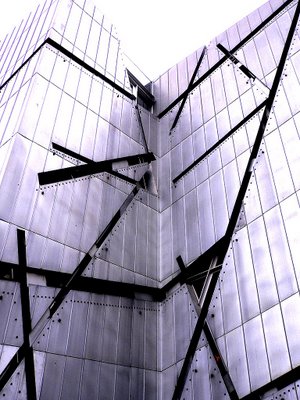 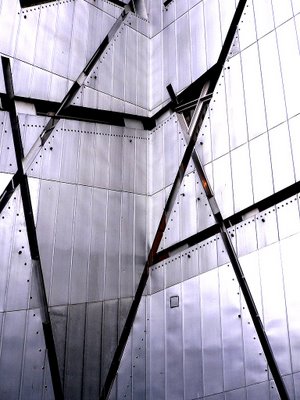 |
 Berlin's Jewish Museum, designed by Daniel Libeskind, is a dizzying construct of geometric forms and sharp edges. Adjoining walls, floors or ceilings seldom, if ever, meet at right angles. Rather the surfaces collide at angles off the perpendicular, conspiring to deceive the eye and the mind, inducing a curious state of mildly vertiginous disorientation, "This is level ground I am standing on, is it not?" Berlin's Jewish Museum, designed by Daniel Libeskind, is a dizzying construct of geometric forms and sharp edges. Adjoining walls, floors or ceilings seldom, if ever, meet at right angles. Rather the surfaces collide at angles off the perpendicular, conspiring to deceive the eye and the mind, inducing a curious state of mildly vertiginous disorientation, "This is level ground I am standing on, is it not?"Clad in titanium-zinc plates, the building's imposing exterior is razor-slashed with clinical ferocity. Open lancinating wounds, intersecting narrow slits of window, let in austere shafts of light. The effect is complete. One is immediately seized and held hostage, overwhelmed by the raw power, stark vision and unnerving strangeness of the architecture. |
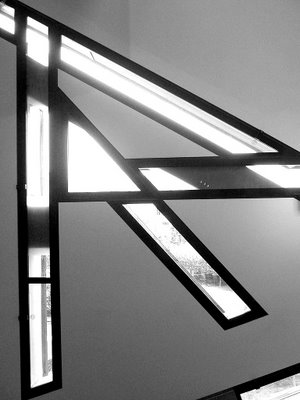 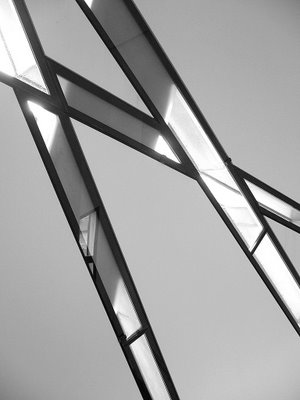 |
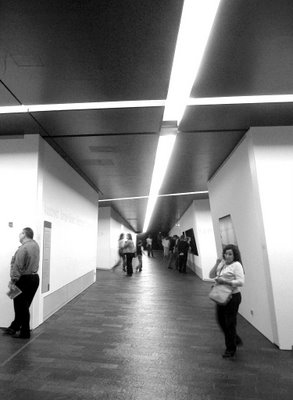 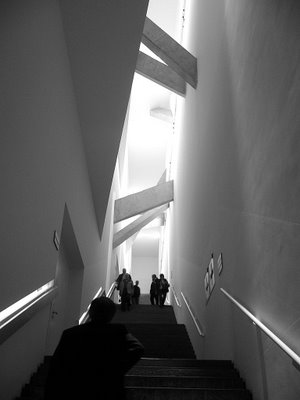  |
Enter the museum via an underground passage from the baroque building next door. Three axes - Axis of Continuity, Axis of Exile, Axis of Death - lie at the foundation of the museum. Walk along the first and climb up a long flight of stairs - overhung by perilous slanting ceiling beams that appear about to tumble down any moment - to reach the permanent exhibit. The main building is skewered by a series of interconnecting void spaces that, desolate and impenetrable, are visible only through narrow glass windows cut into the wall at intervals.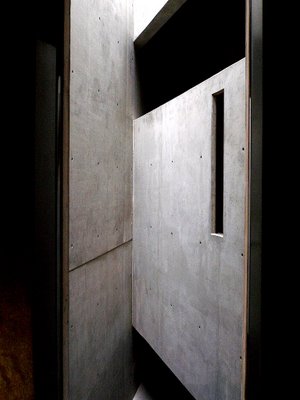 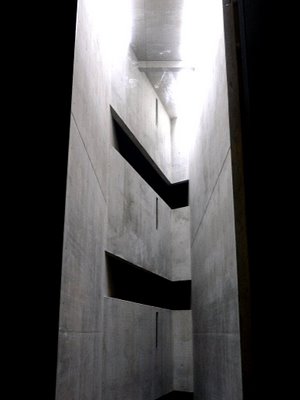  |
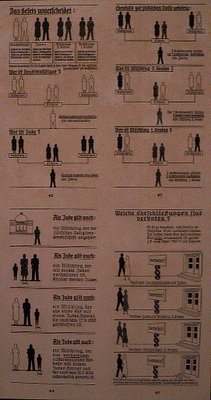 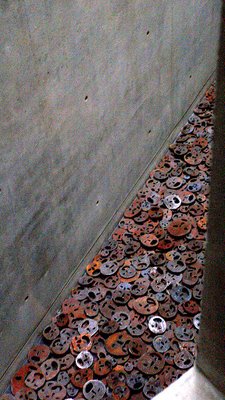 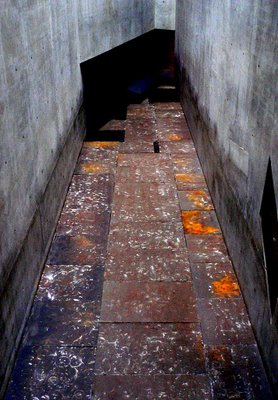 |
| The museum traces the two-thousand-year history of Jews in Germany, and documents their intellectual and cultural contributions. Racial hatred and discrimination, always beneath the surface, raised their ugly heads during the Nazi era. Jewish persecution began with racial laws in the 1930s. Geneology, abtrusely abused, marked Jews and half-Jews from the Aryan race. Miscegenation was verboten. The Holocaust erupted. In one of the void spaces, on the floor, thousands of metal discs resembling human faces - terror-stricken eyes wide open and mouth agape - look up at us: a deafening collective scream. In another, the faces are now gone; their imprints, a patina on the haunted silent ground. |
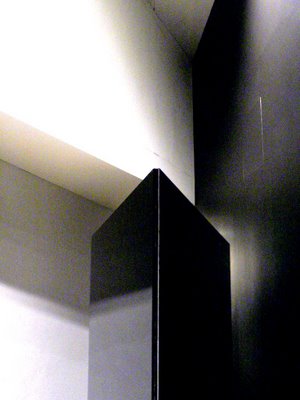 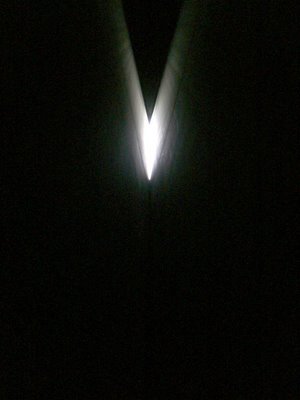 |
| Tall wedged-shaped black granite walls stand at various locations in the exhibition area. Strap on the special headphones. Go very near to the wall to hear the commentary. Nose almost touching the wall, Jerusalem's Wailing Wall comes to mind. Exit the exhibition. Walk along the undergound Axis of Death. At the end, enter the Holocaust Tower, a few at a time. Total isolation, sensory deprivation and cold fear close in. The confined bare concrete space is totally dark, except for light piercing a tiny aperture near the ceiling: the light and its reflection form a shining V, a vestige of hope. |
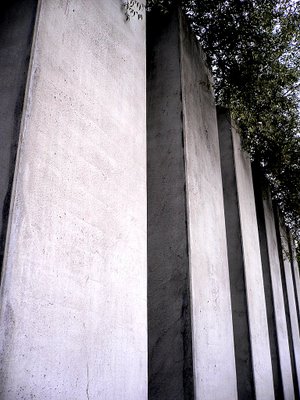 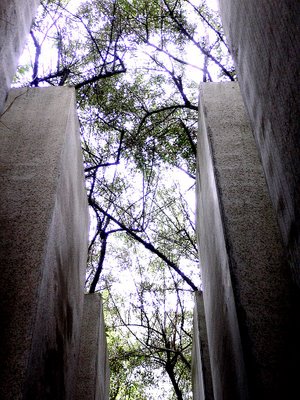  |
Finally, go along the Axis of Exile. Names of cities absorbing the Jewish Diaspora line the walls of the corridor. Push open the rhomboid door at the end and step gingerly - the ground slopes off the horizontal - into the Garden of Exile. Forty-nine concrete stelae, or pillars, stand erect in a grid on a small square set below ground level. On the tops of all except one, plants thrive on Berlin soil. On the last stele, soil from Jerusalem has been symbolically laid. 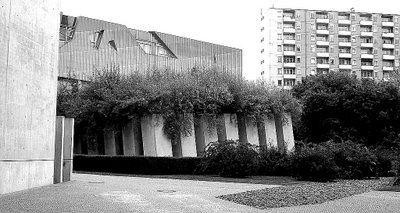 |
Labels: architecture, art, Berlin, Germany, history, museum, religious site
Saturday, July 29, 2006
Eze, France, 29 May 2006: Eze-Village
Walled Mountain Fortress And Nietzsche's Path
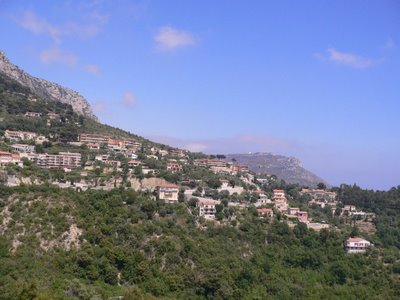 Eze, a fortified village built on the peak of a rocky hill (460m above sea level) overlooking the Mediterranean Sea, is renowned for its expansive panorama. From Nice Gare Routiere, Bus 112 plies the Moyenne Corniche all the way up to Eze-Village, midway between Nice and Monaco: a 15-minute ride. From the bus-stop, climb a short way up an incline to the entrance of the famous Hotel Chevre d'Or. Bear right, and you'll suddenly find yourself transported back in time, immersed in the medieval surrounds of Eze-Village. 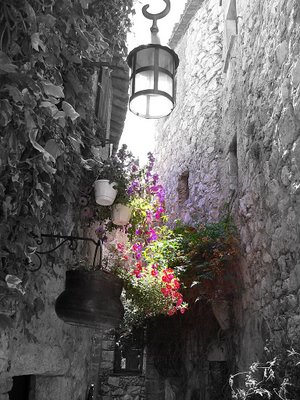  Spiralling cobbled passage ways going uphill and downhill, never flat, encircle Eze-Village. Houses with ancient stone masonry face one another across narrow streets, barely a few metres wide. The sky is glimpsed between overhanging rooftops. For more salutory vistas, dine at the verandah of the Chateau Eze, once owned by the Prince of Sweden, which reputedly gives the best views of the French Riviera. At a price. 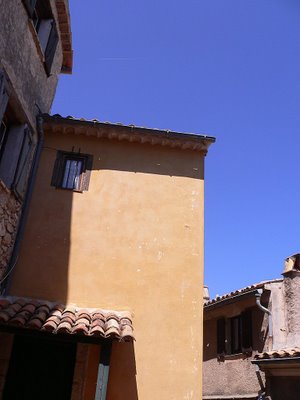 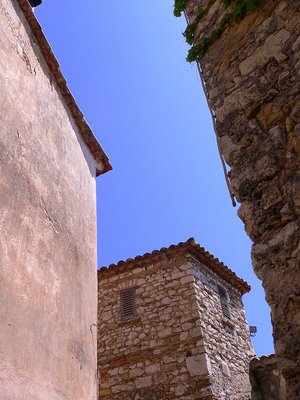 |
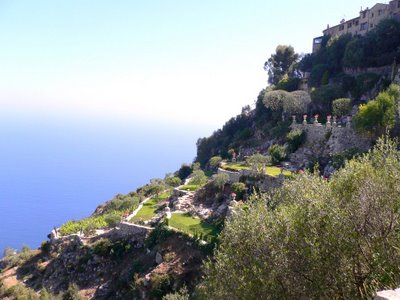 To the right of the Hotel Chevre d'Or entrance, there is a little path, Nietzsche's Path, that goes round the hill face to reach Eze Bord-de-Mer, a seaside village at the base of the hill. A small clearing opens up a short distance down the path. From here, look right to see the exquisite terraced gardens that buttress Eze-Village. 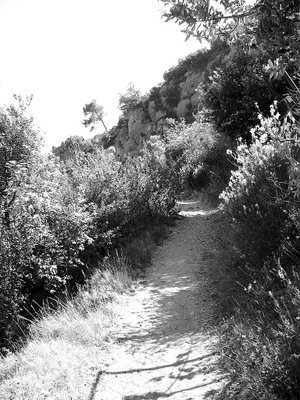 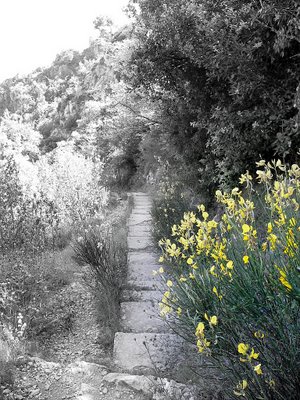 Nietzsche, the writer-philosopher, used to climb up the path (a good one-and-a-half hour's brisk work; 45 minutes going down), and was especially inspired by the scenery. Here, he formulated major parts of his magnum opus Also sprach Zarathustra. 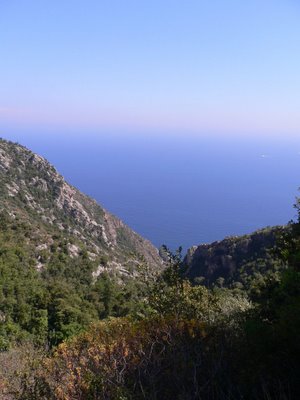 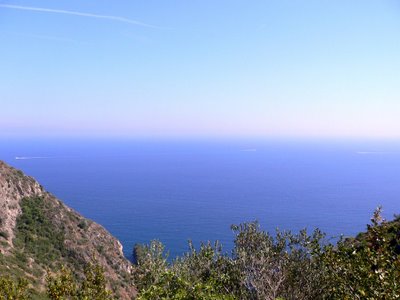 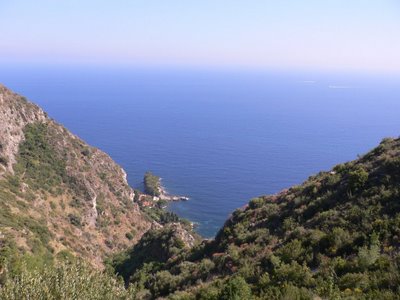 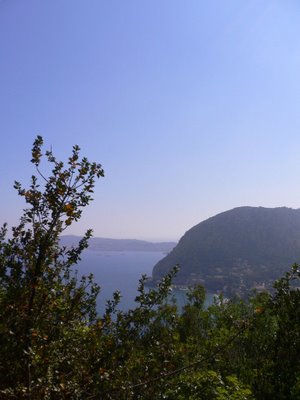 Eze Bord-de-Mer waits invitingly at the other end of the path. From here, take Bus 100 back to Nice. Alternatively, catch the train that runs along the Cote d'Azur. 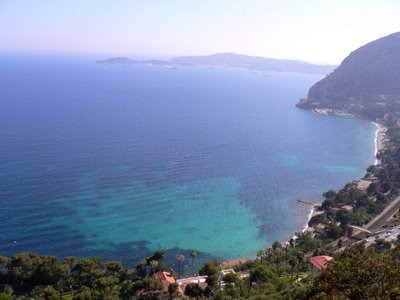 |
Labels: Cote d'Azur, Eze, France, history, nature, sea
Sunday, July 09, 2006
Beijing, China, 16-19 February 2006: Imperial Palaces
Forbidden Palace & Summer Palace, In Winter
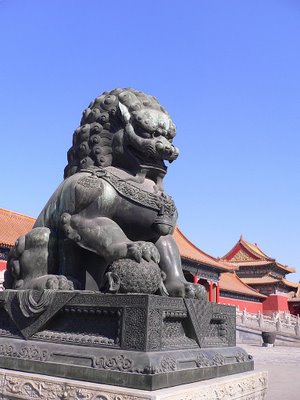 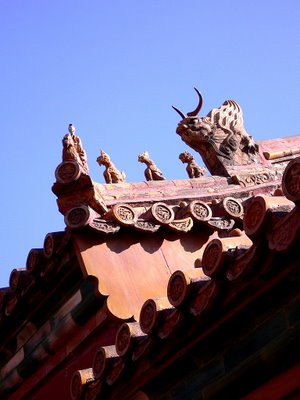 The Forbidden Palace was the seat of Qing dynastic rule for over 400 years. Guardian lions and fantastical rooftop beasts stand in perpetual vigil, casting magic protection over the Manchu emperor and his royal retinue. Emperor Qian Long reigned 60 years. His calligraphic inscription Zheng Da Guang Ming - Incorruptible Righteousness - hangs above his throne. 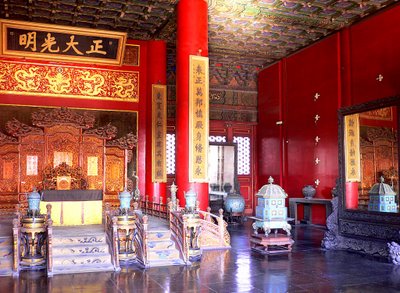 |
  Believed to ward off evil charms and spirits, auspicious red is everywhere. Palace walls and courtyard gates are coated in burnished crimson hues. Delicate ceramic tiles with recurring floral peony motifs adorn walls and columns. 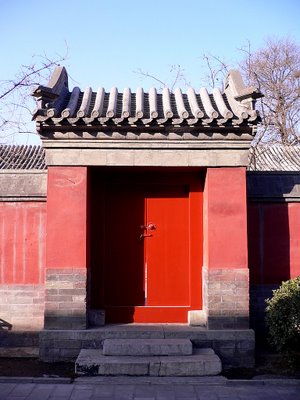 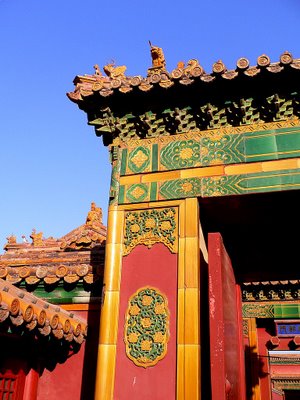 |
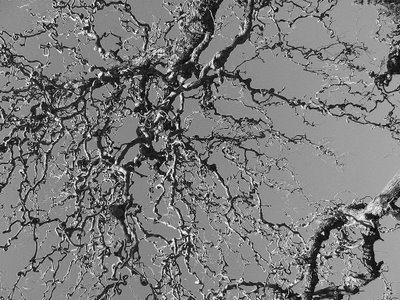 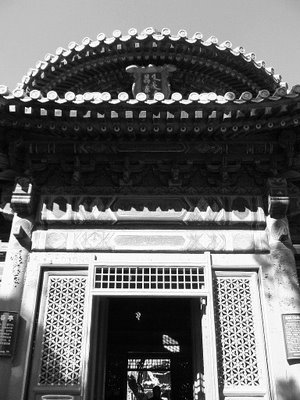 The Imperial Garden, behind the royal palaces, edges the northern palace wall. Within its compact compound, stylized rock sculptures, miniature pavilions and countless ornamental trees, centuries old, are meticulously laid out, no doubt after strict Feng Shui principles. |
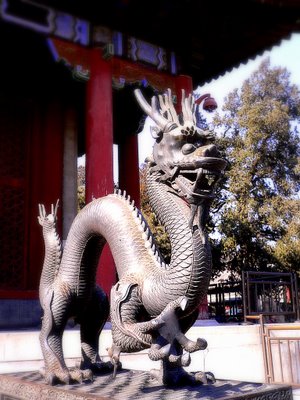 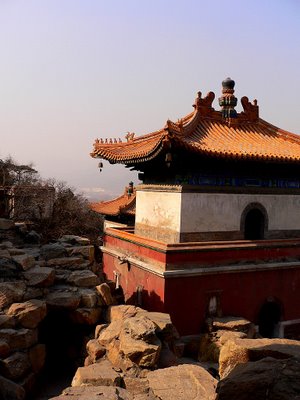 The Summer Palace, Yi He Yuan, was rebuilt following Western army ruination, using war funds expropriated by the infamous Empress Dowager Ci Xi. It became her summer Xanadu. Palaces were erected on Wan Shou Shan - Longevity Mount - and on the banks of Kunming Lake at its base. Temples built for imperial religious edification dot the landscape. Times have not been kind. Beheaded Buddha statues are scarred reminders of zealous cultural purification in the 60's. 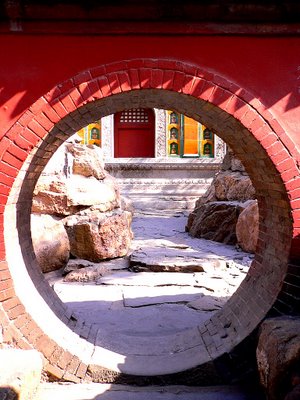  |
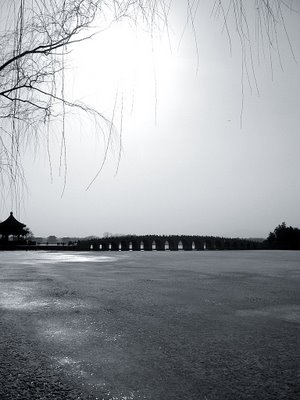 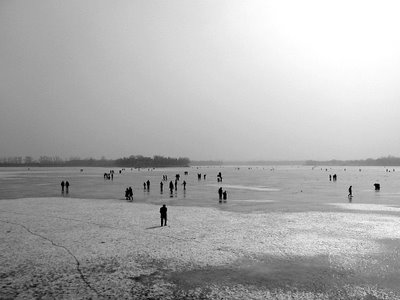  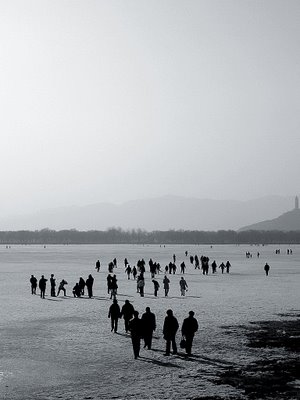 |
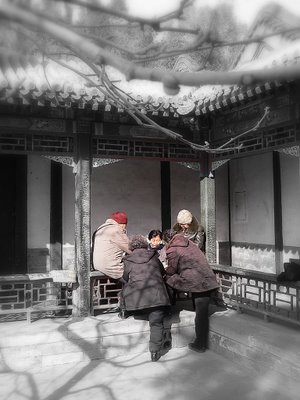 A long gallery Chang Lang connects the pavilions ringing Kunming Lake. Strolling, I chance upon these women playing cards. With impenetrable quiet concentration. |
Labels: Beijing, China, history, lake, palace, religious site

Licensed under Creative Commons Attribution-NonCommercial-NoDerivs 2.5 License

These are the 30 countries that I have ever set foot on. Airport stopovers don't count!
